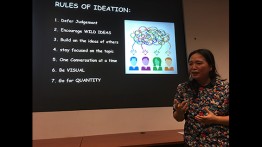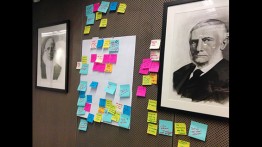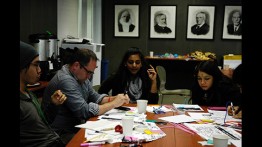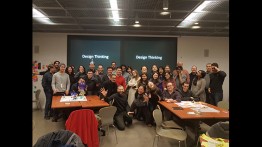Design Thinking Workshop Attracts Students from All Three Schools
POSTED ON: February 7, 2017
During the last weekend of January, 23 students from the three schools, 4 faculty, and 3 staff members participated in the Design Thinking Boot Camp; a 2-day workshop centered on teaching a methodology for creative problem solving used by many innovative firms, educators and scientists. The workshop was co-organized by Dr. Eric Lima, associate professor of mechanical engineering and Lee Kim, Cooper alumnus (class of 2000, Mechanical Engineering) and adjunct professor (EID103- Principles of Design).
Design thinking is a method of inquiry that came into mainstream discourse during the 1980s and has been applied to a wide range of problems, from how to create meaningful work to how to redesign a classroom to better meet students' needs. The problem the 30 participants of the workshop were tackling was how to better promote a sense of community between the three schools at The Cooper Union.
Professor Lima planned the two-day event with an eye to bringing students from all disciplines into the conversation. “Design thinking can be a revelation for its participants. It is essentially a step-by step process of listening to other people to find opportunities to help them. It can be very motivating because the process is grounded in dialogue - you systematically seek other people’s stories and unpack them to understand what their needs are. The process is geared towards addressing big, messy problems… The ones that really matter.”
A central tenet of design thinking is understanding a problem from the perspective of the people directly affected. That idea made a big impression on Isak Ishrak, a senior in the School of Art. “The workshop made us learn how to focus and prioritize empathetic understanding of our user before designing any type of solution. It was encouraged that we did not think that we knew what the problem was and from a space of curiosity we reached out and did research to broaden and then focus our understanding of the problem based on what the user needs.”
Nine volunteers, colleagues of Ms. Kim’s who all donated their time to the workshop, helped lead the “boot camp,” all experts at applying design thinking to everything from sustainable design to the entertainment industry to community organizing. The 30 participants worked in teams of five, working through a series of exercises around the topic of promoting community at The Cooper Union. They interviewed students (not those in the workshop) to understand what was needed to make more community. Pranav Joneja, a third-year mechanical engineering student said that the workshop shed a lot of light on how to conduct an interview. “In particular, he said, “I learned how to glean the interviewee's thoughts and opinions on the topic without directly asking them about it. Otherwise, the interviewee answers in a way that is influenced by what they think you want to hear. I learned how to distinguish body language from verbal answers.”
After analyzing the data from the interviews, they created an archetype student, Gabi, who was experiencing isolation from friends and activities under the weight of school work. Each team generated ideas to relieve Gabi’s isolation and then tested those ideas on students that were not part of the workshop. This was done by rapidly producing props to used in an immersive skit that would demonstrate the gist of the idea as if all the necessary technology and services already existed. Participants in the skit would gauge the reaction of the audience to determine the effectiveness of the idea and to generate ideas for further refinement of their idea.
Lee-Sean Huang is co-founder and creative director at Foossa, which works with companies, non-profits, and government agencies to better understand and reach their audience. He was a team leader for a group of engineers and artists during the Cooper boot camp. He explains design thinking as an approach to problem solving that puts people at its center. “But design thinking is more than problem solving, it's also about reframing problems to deliver value. There is an old joke: how many design thinkers does it take to change a lightbulb? Punchline: Does it need to be a lightbulb?” Which is to say, design thinking is a method that not only finds answers, but analyzes the very questions being asked.
A first-year architecture student, Irisa Llana, applied to the workshop to collaborate with students from the other schools: “I was excited to have the chance to work with students from different majors, do something outside my routine and introduce myself to new opportunities.” A freshman in mechanical engineering, Sophie Schneider attended for the same reason, looking to work with students outside of engineering as well as upperclassmen and faculty. She also was curious about design thinking. “The workshop showed me the value in slowing down and breaking up each part of the design process. It was valuable to be able to work on solving a problem in a very structured way—very different than I usually work,” she said.









